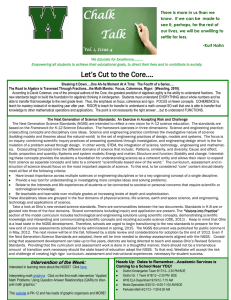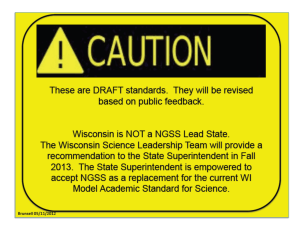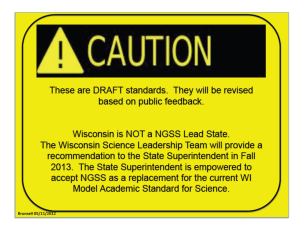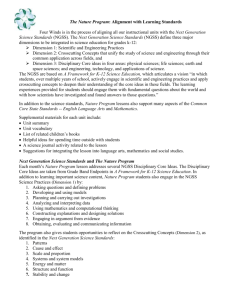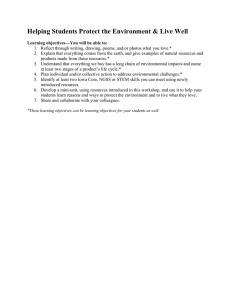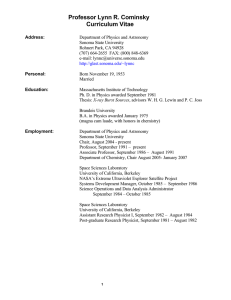Prof. Lynn Cominsky Sonoma State University Next Generation
advertisement
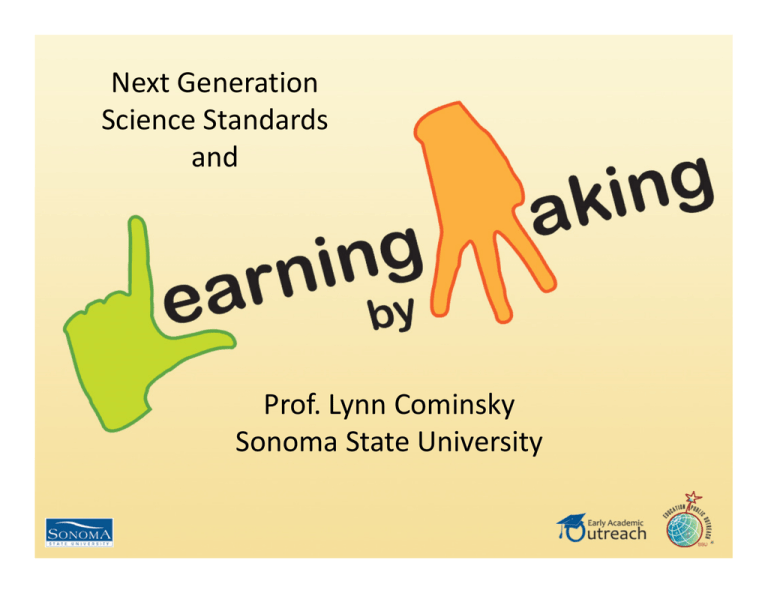
Next Generation Science Standards and Prof. Lynn Cominsky Sonoma State University 1 Next Generation Science Standards • Developed in multiyear process by NRC • Adopted by 26+ states • Teaching and learning science the way it is really done – not just a collection of facts to memorize 1 2 Three Dimensions • Scientific and engineering practices – Describe behaviors that scientists engage in as they investigate and build models and theories about the natural world. – Key set of engineering practices that engineers use as they design and build models and systems. • Crosscutting concepts – Have application across all domains of science. – Link the different domains of science. • Disciplinary core ideas – Focus K–12 science curriculum, instruction and assessments on the most important aspects of science. 2 3 How to View • The three dimensions need to be considered as an integrated system. • Practices are the processes of building and using the core ideas to make sense of the natural and designed world 3 Defining the Dimensions 4 5 What are scientific practices? • Behaviors that scientists engage in as they investigate and build models and theories about the natural world. • Used instead of a term like “skills” to emphasize that engaging in scientific inquiry requires coordination of both knowledge and skills simultaneously. • Use of the term practices helps avoid the interpretation of skill as rote mastery of an activity or procedure. • Part of the NRC’s intent is to better explain and extend what is meant by “inquiry” in science and the range of cognitive, social, and physical practices that it requires. 5 What are Crosscutting Concepts? • Crosscutting concepts have application across all domains of science. • They help link the different domains of science. – – – – – – – Patterns, similarity, and diversity; Cause and effect; Scale, proportion and quantity; Systems and system models; Energy and matter; Structure and function; Stability and change. 6 What are disciplinary core ideas? • Focus K–12 science curriculum, instruction and assessments on the most important aspects of science. Should have at least two of the following: – Have broad importance across multiple sciences or engineering disciplines or be a key organizing concept of a single discipline; – Provide a key tool for understanding or investigating more complex ideas and solving problems; – Relate to the interests and life experiences of students or be connected to societal or personal concerns that require scientific or technological knowledge; – Be teachable and learnable over multiple grades at increasing levels of depth and sophistication. • Disciplinary ideas are grouped in four domains: the physical sciences; the life sciences; the earth and space sciences; and engineering, technology and applications of science. 7 Conceptual Shifts in the NGSS 1. K–12 science education should reflect the real world interconnections in science 2. Using all practices and crosscutting concepts to teach all core ideas all year 3. Science concepts build coherently across K-12 4. The NGSS Focus on deeper understanding and application of content 5. Integration of science and engineering 6. Coordination with Common Core State Standards 8 9 Standards Comparison: Structure and Properties of Matter Current State Middle School Science Standard a. b. c. d. e. f. g. NGSS Middle School Sample Distinguish between atoms and molecules. Describe the difference between pure substances (elements and compounds) and mixtures. Describe the movement of particles in solids, liquids, gases, and plasmas states. Distinguish between physical and chemical properties of matter as physical (i.e., density, melting point, boiling point) or chemical (i.e., reactivity, combustibility). Distinguish between changes in matter as physical (i.e., physical change) or chemical (development of a gas, formation of precipitate, and change in color). Recognize that there are more than 100 elements and some have similar properties as shown on the Periodic Table of Elements. Identify and demonstrate the Law of Conservation of Matter. a. b. c. d. 9 Construct and use models to explain that atoms combine to form new substances of varying complexity in terms of the number of atoms and repeating subunits. Plan investigations to generate evidence supporting the claim that one pure substance can be distinguished from another based on characteristic properties. Use a simulation or mechanical model to determine the effect on the temperature and motion of atoms and molecules of different substances when thermal energy is added to or removed from the substance. Construct an argument that explains the effect of adding or removing thermal energy to a pure substance in different phases and during a phase change in terms of atomic and molecular motion. 10 Why not inquiry ? • Engineering design is similar to scientific inquiry, but there are significant differences. • Scientific inquiry involves the formulation of a question that can be answered through investigation, while engineering design involves the formulation of a problem that can be solved through design. 10 11 CC Literacy in Science vs. NGSS • The CCSS Literacy Standards were written to help students meet the particular challenges of reading, writing, speaking, listening, and language in their respective fields-in this case, science. • The literacy standards do not replace science standards-they supplement them. • The NGSS will lay out the core ideas and practices in science that students should master in preparation for college and careers. 11 What is Learning by Making? • One of only 18 Investing in Innovation (i3) development projects awarded in 2013 by the U.S. Department of Education • Five-year program to develop engaging, hands on, project-based learning that integrates science and mathematics • 2 new high school STEM courses: – Environmental Science/Biology – Chemistry/Physics 12 Learning by Making team • PI Susan Wandling (SSU Early Academic Outreach) • STEM Lead Lynn Cominsky (SSU Education and Public Outreach) • Mendocino County Office of Education • Six partner rural high-needs high schools: – Anderson Valley – Point Arena – Ukiah Fort Bragg Round Valley Willits 13 Innovations • Use of computational thinking to focus on real world problem solving • Solutions are constructed by teachers and students working together • Use of Logo programming language – overcomes barrier to learning how to code • Sensor based experiments that are networked • Simulations and modeling 14 Our goals • Develop two year-long integrated high school STEM courses that will be accepted as elective credit for university eligibility in California • Train at least half of the science and mathematics teachers in our partner schools to successfully deliver the curriculum • Improve math and science proficiency by 15% for students enrolled in the new courses. 15 2014 Summer Institute First year work plan overview • Write a Logo manual and build hardware platform • Initial design of Environmental Science and Biology experiments and sensor selection • Visit with teachers and principals to understand needs, infrastructure and how to successfully implement these ideas at the schools • 10 days of professional development for teachers • Set up web-based infrastructure to allow real time debugging with teachers and students • Submit curriculum to UCOP for college-credit approval as Laboratory Science (Area D) 17 Hardware Interface Design • Modeled on SSU’s first Earth-orbiting satellite (TLogoQube) – MSP 430 microprocessor • Uses packet-based data stream and radios for remote sensors “in the field” • Networks of sensors allow students to work together on experiments Top view Bottom view 18 Curriculum overview – year 1 19 Light and temperature experiment • Four temperature sensors at different depths in sand • Light can be controlled to simulate day/night and adjusted to provide solar flux at surface • Simulation of diffusion model using Logo • Comparison to real borehole measurements to learn about Earth temperature history 20 Organism growth experiment • Microbes that create electricity by ingesting wastes – current increases as population grows • Useful for bioremediation of oil or winery wastes • Simulation of population growth and genetic propagation models using Logo • Comparison to real populations (e.g., foxes vs. rabbits) and GMOs 21 Environmental quality experiment • Measure radiation, air quality or water quality in local environment • Compare to global, national or regional data bases – http://blog.safecast.org - maps radiation levels and builds a sensor network, enabling people to contribute and freely use the data collected. – http://www.airnow.gov/- air quality maps of US, including particles and ozone – http://waterwatch.usgs.gov – continuous real-time water quality maps of surface water in US, including discharge, nitrates, pH and more 22 2015 Next Steps • Finish lesson plans for year 1 curriculum • Finish other two year 1 hardware experiments • Finish remote laboratory interface implementation • Sign students up for year 1 class • Purchase and distribute year 1 materials • Start Learning by Making! 23 For more information: • http://i3.sonoma.edu Public Files • Thanks to Christine Royce and Stephen Pruitt for many of the NGSS slides • http://epo.sonoma.edu to learn about all of our projects • Cominsky Close to Home op-ed in 12/5/2014 Press Democrat http://www.pressdemocrat.com/opinion/320 4004-181/close-to-home-new-standards 24
